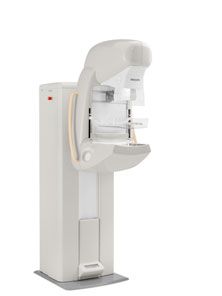Photon-Counting Takes on MBIS and Tomosynthesis Products at RSNA 2011
Philips will highlight its newly released MicroDose Mammography System at RSNA 2011. The Philips unit will go head to head with other new entries in the mammography space including Hologic’s 3-D breast tomosynthesis product, Selenia® Dimensions, whole breast ultrasound from U-Systems, Dilon’s 6800 MBI scanner, and GE’s Discovery MB750b, a molecular breast imaging system.
Philips will highlight its newly released MicroDose Mammography System at RSNA 2011.
The Philips unit will go head to head at RSNA with other new entries in the mammography space including Hologic’s 3-D breast tomosynthesis product, Selenia® Dimensions (previewed at RSNA in 2010 and FDA approved in February 2011), whole breast ultrasound from U-Systems, Dilon’s 6800 MBI scanner, and GE’s Discovery MB750b, a molecular breast imaging system.

Philips’ system is the first in the US to use photon-counting technology, designed to improve clarity while reducing dose. Photon counting reduces the number of intermediate conversion steps needed to create a digital signal. Each conversion can reduce image quality. The MicroDose system delivers no ghost images and a 50 µm pixel size at 100 percent pixel accuracy, according to Kim Holttum, senior director of global marketing, Women’s Health Care, Philips Healthcare. The field of view is 24 by 26 cm.
Plus, the dose is about half that of full-field digital mammography (FFDM) systems, Holttum says. Automatic exposure control (AEC) can adjust dose based on breast density.
The units also are fast. With no wait time between acquisitions, exams take only 4 minutes, making it possible to do 12 to 18 exams an hour, Holttum estimates. That’s good for patients, technologists, and the bottom line.
AI-Initiated Recalls After Screening Mammography Demonstrate Higher PPV for Breast Cancer
March 18th 2025While recalls initiated by one of two reviewing radiologists after screening mammography were nearly 10 percent higher than recalls initiated by an AI software, the AI-initiated recalls had an 85 percent higher positive predictive value for breast cancer, according to a new study.
ECR Mammography Study: Pre-Op CEM Detects 34 Percent More Multifocal Masses than Mammography
February 28th 2025In addition to contrast-enhanced mammography (CEM) demonstrating over a 90 percent detection rate for multifocal masses, researchers found that no significant difference between histological measurements and CEM, according to study findings presented at the European Congress of Radiology.
Study: Mammography AI Leads to 29 Percent Increase in Breast Cancer Detection
February 5th 2025Use of the mammography AI software had a nearly equivalent false positive rate as unassisted radiologist interpretation and resulted in a 44 percent reduction in screen reading workload, according to findings from a randomized controlled trial involving over 105,000 women.